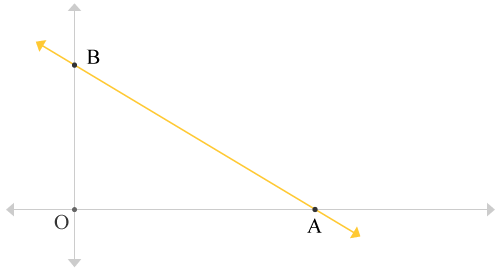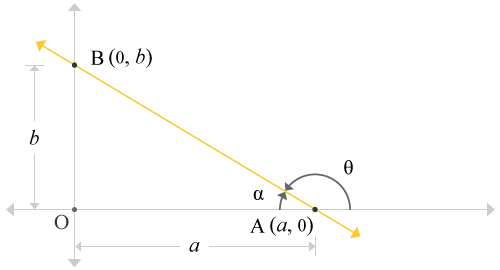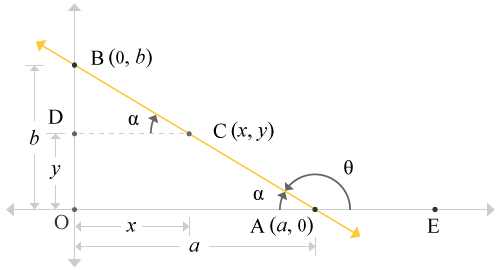Expressing equation of a straight line in terms of X-intercept and Y-intercept when the straight line intersects both axis is defined Equation of a straight line in terms of X-intercept and Y-intercept.
It is another special case. You have seen straight line with X-intercept and slope and also seen straight line with Y-intercept and slope but this case this entirely different to them. Straight lines may also pass through both axis at an X-intercept as well as at a Y-intercept. It can be also be denoted by the General form of the straight line but it is transformed into X-intercept and Y-intercept form when both intercepts are substituted in the standard equation of the straight line.
Assume, AB↔ is a straight line and it crosses the horizontal x-axis at an intercept and also it passes through the vertical y-axis at another intercept.

The straight line AB↔ is intersected the horizontal x-axis at a point A at an x-intercept of a units. Therefore, the point A is located at (a, 0) in the Cartesian coordinate system. Similarly, the straight AB↔ is intersected the vertical y-axis at a point B at a y-intercept of b units. So, the point B is located at (0, b) in geometric coordinate system. Thus, the straight line AB↔ is formed a right angled triangle ΔBAO. Assume, the straight line AB↔ is making an angle theta (θ) with the horizontal x-axis.

According to right angled triangle ΔBAO.
The line segment AB‾ is known hypotenuse of the right angled triangle ΔBAO.
The line segment OA‾ is known adjacent side of the right angled triangle ΔBAO.
The line segment OB‾ is known opposite side of the right angle triangle ΔBAO.
Assume, the angle between hypotenuse AB‾ and adjacent side OA‾ is alpha α. The angle of the right angled triangle ΔBAO is ∠BAO = α.
Consider a point on the straight line AB↔ and assume it to call point C and also the coordinates of the point C is (x, y). The point C(x, y) represents each and every point on the line including the points A and B. Now, draw a horizontally parallel line from point C towards vertical axis. Assume, the parallel line perpendicularly meet the y-axis at a point, assumed to call point D. Thus, another right angled triangle ΔBCD is formed by the part of the straight line AB↔.

Assume, point E is a point on the horizontal x-axis. The exterior angle of the right angled triangle ΔBAO is ∠BAE = θ . The summation of the angle of the triangle and exterior angle is 180° because the summation of the angles forms a straight angle.
Therefore, θ+α = 180°
⇒ α = 180° – θ
According to right angled triangle ΔBAO,
tanα = OBOA
The length of the opposite side (OB‾) of the right angled triangle ΔBAO is OB = b.
The length of the adjacent side (OA‾) of the right angled triangle ΔBAO is OA = a.
⇒ tanα = OBOA = ba
Now replace the angle alpha (α) in terms of theta (θ).
⇒ tan(180° – θ) = ba
180° – θ means, tangent function is brought to second quadrant. In second quadrant, the trigonometric ratio tangent is negative.
⇒ -tan θ = ba
⇒ tan θ = -ba
According to the concept of slope of a straight line, slope of a straight line (m) = tan θ.
⇒ m = -ba
Similarly, as per the right angled triangle ΔBCD,
tanα = DBDC
The length of the opposite side (DB‾) of the right angled triangle ΔBCD is DB = OB-OD = b-y.
The length of the adjacent side (DC‾) of the right angled triangle ΔBCD is DC = x.
tanα = DBDC = b-yx
⇒ tan(180° – θ) = DBDC = b-yx
⇒ -tanθ = b-yx
⇒ tanθ = -(b-yx)
⇒ m = -(b-yx)
Finally, the slope of the same straight line AB↔ is obtained in terms of the coordinates of the points of the line and slope of the straight line from both triangles ΔBAO and ΔBCD.
m = -ba and m = -(b-yx). These two expressions are equal in value because they both represent slope of the same straight line.
⇒ -ba = -(b-yx)
⇒ ba = b-yx
⇒ xa = b-yb
⇒ xa = bb – yb
⇒ xa + yb = bb
⇒ xa + yb = 1
This algebraic expression represents a straight line when the straight passes through both axis of the Cartesian coordinate system through at x-intercept and y-intercept.
A free math education service for students to learn every math concept easily, for teachers to teach mathematics understandably and for mathematicians to share their maths researching projects.
Copyright © 2012 - 2023 Math Doubts, All Rights Reserved